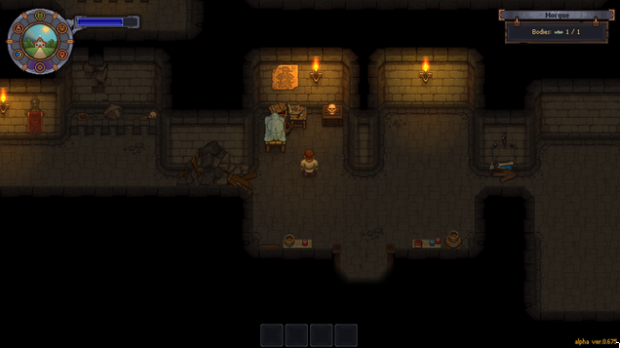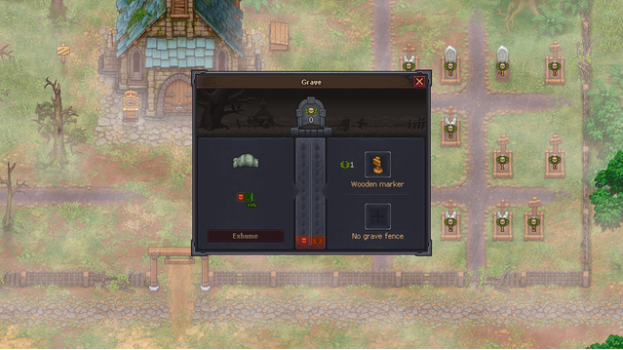As a regular Stardew Valley player and an avid horror fan, I went into Lazy Bear Games’ Graveyard Keeper, currently in Alpha, expecting that it was probably going to be my thing — and I was very much correct.
However, Graveyard Keeper isn’t just a creepy remake of the infamously addictive farming game. While some of the basic gameplay, from growing crops to fighting bright green goo, might be startlingly familiar, dumping rotting corpses in rivers, harvesting organs, performing sermons, and paying taxes to an unforgiving church and king are great reminders that Graveyard Keeper is very much its own game. And even in Alpha, there’s a lot it has to offer.
So You’re the New Groundskeeper

You start out Graveyard Keeper as a rather confused, bearded man whose death has just transported him from the present day to a mimicry of medieval Europe. Your new role is as a groundskeeper for the local cemetery and caretaker of the church. And your first task is to find Gerry.
Gerry, as it turns out, is a floating skull you dig up right behind your house. Also, he’s your new best friend.
From the get-go, the game does a great job of introducing directions and tutorials through characters like Gerry. As the former graveyard caretaker, he provides inside knowledge about where you can pick up bodies, where to take them, and how to harvest their organs. For your first body, Gerry will instruct you to remove chunks of flesh to sell to the local tavern for money — and beer — which really kind of sets the tone for the whole game.
Harvesting More Than Just Berries

In truth, the entire system behind taking care of corpses in Graveyard Keeper really adds an interesting challenge to the seasonal time limits you’d find in a game like Stardew Valley. Realistically, all corpses in Graveyard Keeper decay, and when they decay, things gets bad on multiple levels.
Each body in the game has a skull rating (signaled by white, red, or green skulls) and starts at 100% freshness as soon as it’s dropped off. However, once it hits the ground, it begins to drop by 1% every 30 seconds. As the “freshness” percentage of a corpse drops, its rating decreases, which affects not only the meat you harvest from the body but also the rating of your graveyard as a whole. Poorly rated bodies can lead to negative graveyard points, no matter how nicely you dress up the graves.
This adds an element of urgency on top of the normal day/night cycle and can lead to a lot of unethical decisions to spare yourself some time. For example, if you’re trying to save your graveyard’s rating, you can dump horribly decayed and poorly rated corpses into the river, never to be seen again. You can also stall the drop-off of bodies by placing them into graves without burying them, which also prevents the process of decay.
As you progress through the game and the bodies start piling up, you’ll find yourself cutting corners or interring corpses without proper burials so you can peacefully go about your day, which, in my opinion, adds an amusingly morbid charm to the whole system.

These tricks also help alleviate some of the areas in the game I found frustrating — like how short the days are and how easily you expend energy. Time in Graveyard Keeper passes very quickly. However, you aren’t forced to sleep, so you could feasibly stay up forever, or at least until your health or energy run out. Fortunately, cooking and consuming your own food for energy is really easy. You can start making your own food as soon as you start foraging or farming.
The short days are also an issue when trying to complete tasks, as certain quest givers are only in specific areas on set days. While the week moves quickly enough that it’s not so terrible when you miss them, the short days can cause a problem when you’re new to the map. For example, trying to trek your way from your home through the village and to the lighthouse can eat up half a day or more. And while you can make your character sprint, it’s a short burst that takes up energy.
Still, while I do wish it were easier to conserve energy and that the days were a bit longer, as you get further along in the game, these things become less of a challenge. You create tools that operate at 100% efficiency rather than 50%, which means you aren’t losing so much energy when harvesting materials. You’ll also start to stock up on food so you don’t have to sleep as much to replenish energy, meaning you can get more done.
Investing in Skill Trees

Another interesting aspect of the game is the technology trees. Seemingly straightforward, the technologies in Graveyard Keeper basically work like skill trees. They’re broken down into six categories, from Theology to Smithing, and can be unlocked using points that you accumulate through doing work. There are three points in total, all a different color.
Red Points represent your handcrafting skills and ability to work with materials. You get these through crafting on your workbenches or breaking down stones. Green Points represent your knowledge about the nature of things and nature itself. These points are the most plentiful, and you can get them through digging up dead shrubs, planting crops, etc. Lastly, Blue Points represent your spiritual knowledge of the immaterial world — so anything you “research” or “study” in-game should get you Blue Points. These points are probably the most confusing as you can’t actually get them until you complete one of the first big tasks in the game, opening the church.
And though I enjoyed the way the technology trees were laid out in the game, I admit it was a bit unclear that certain technologies were going to serve you better than others when you first start out. The game doesn’t care what you pick as long as you have the points, so you could spend all of them in Theology or dissecting corpses before you realize those skills aren’t going to help you as much as wood crafting will.
Fortunately, even if you do end up putting your points into technologies that aren’t useful in the moment, it’s really easy to get more.
It’s a Big, Wide World Out There

Lastly, though it can be daunting at first, the size of the map in Graveyard Keeper is one of its best assets. Besides your house, farm, and the graveyard, there’s Witch Hill, The Village, The Lighthouse, The Wheat Field, The Beach, and more. Each area has its own set of NPCs for you to engage with, as well as parts of the larger story that can lead to new tasks, new responsibilities, and even more areas.
And while there are still a few kinks to work out — misspellings, missing NPCs, and freezing, to name a few — the game feels pretty complete despite still being in Alpha. I look forward to seeing what the official launch brings in August, but until then, I’ll continue my quest to have the nicest graveyard around.
—
Be sure to stick with GameSkinny for all things Graveyard Keeper, and if you’re new to the game and looking to get started on the right foot, check out our Graveyard Keeper beginner’s guide!







Published: Jun 6, 2018 09:38 am